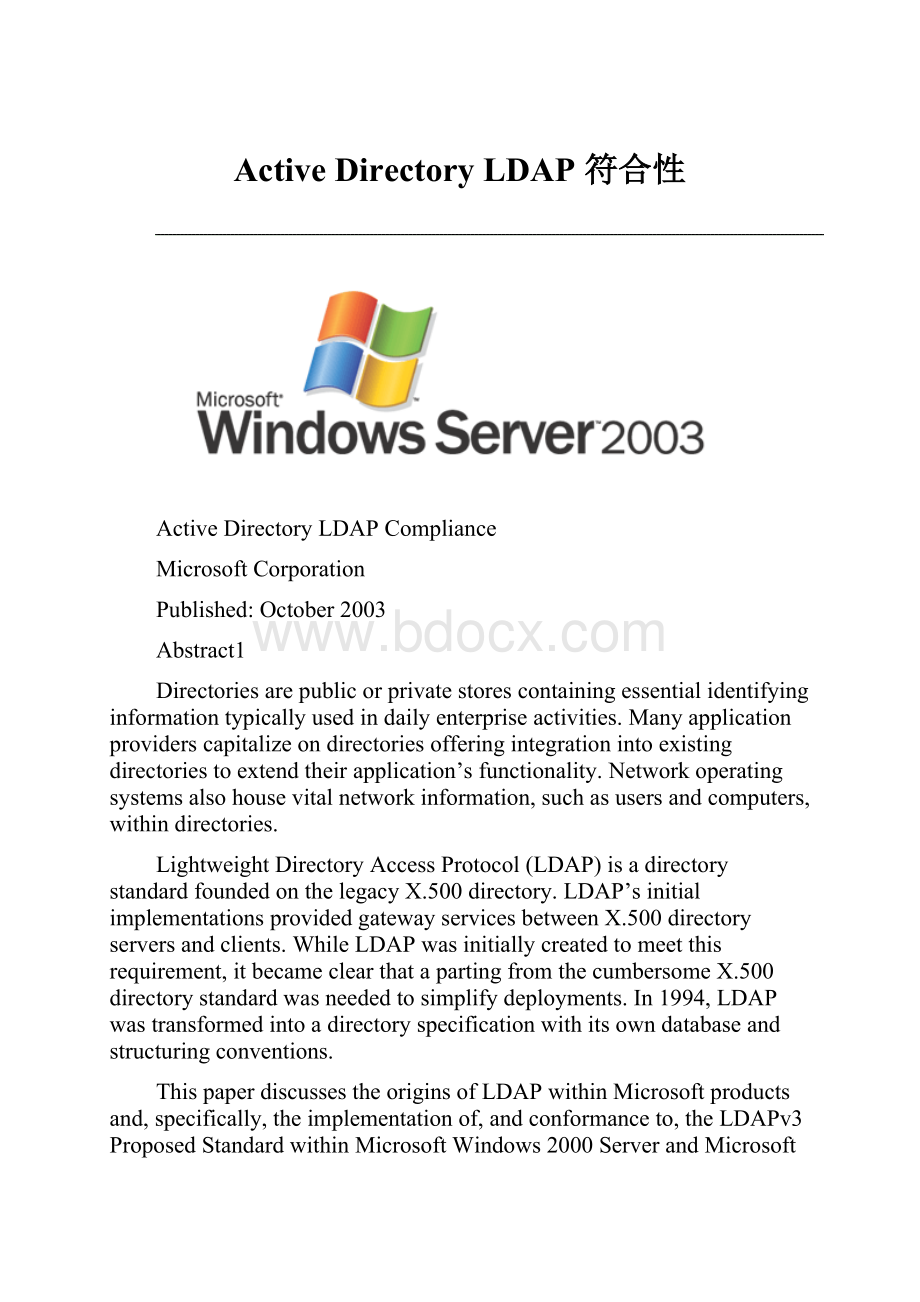Active Directory LDAP 符合性.docx
《Active Directory LDAP 符合性.docx》由会员分享,可在线阅读,更多相关《Active Directory LDAP 符合性.docx(21页珍藏版)》请在冰豆网上搜索。

ActiveDirectoryLDAP符合性
ActiveDirectoryLDAPCompliance
MicrosoftCorporation
Published:
October2003
Abstract1
Directoriesarepublicorprivatestorescontainingessentialidentifyinginformationtypicallyusedindailyenterpriseactivities.Manyapplicationproviderscapitalizeondirectoriesofferingintegrationintoexistingdirectoriestoextendtheirapplication’sfunctionality.Networkoperatingsystemsalsohousevitalnetworkinformation,suchasusersandcomputers,withindirectories.
LightweightDirectoryAccessProtocol(LDAP)isadirectorystandardfoundedonthelegacyX.500directory.LDAP’sinitialimplementationsprovidedgatewayservicesbetweenX.500directoryserversandclients.WhileLDAPwasinitiallycreatedtomeetthisrequirement,itbecameclearthatapartingfromthecumbersomeX.500directorystandardwasneededtosimplifydeployments.In1994,LDAPwastransformedintoadirectoryspecificationwithitsowndatabaseandstructuringconventions.
ThispaperdiscussestheoriginsofLDAPwithinMicrosoftproductsand,specifically,theimplementationof,andconformanceto,theLDAPv3ProposedStandardwithinMicrosoftWindows2000ServerandMicrosoftWindowsServer2003.IncludedforreferencearematrixesdetailingsupportedRFCs.
TheinformationcontainedinthisdocumentrepresentsthecurrentviewofMicrosoftCorporationontheissuesdiscussedasofthedateofpublication.BecauseMicrosoftmustrespondtochangingmarketconditions,itshouldnotbeinterpretedtobeacommitmentonthepartofMicrosoft,andMicrosoftcannotguaranteetheaccuracyofanyinformationpresentedafterthedateofpublication.
Thisdocumentisforinformationalpurposesonly.MICROSOFTMAKESNOWARRANTIES,EXPRESSORIMPLIED,ASTOTHEINFORMATIONINTHISDOCUMENT.
Complyingwithallapplicablecopyrightlawsistheresponsibilityoftheuser.Withoutlimitingtherightsundercopyright,nopartofthisdocumentmaybereproduced,storedinorintroducedintoaretrievalsystem,ortransmittedinanyformorbyanymeans(electronic,mechanical,photocopying,recording,orotherwise),orforanypurpose,withouttheexpresswrittenpermissionofMicrosoftCorporation.
Microsoftmayhavepatents,patentapplications,trademarks,copyrights,orotherintellectualpropertyrightscoveringsubjectmatterinthisdocument.ExceptasexpresslyprovidedinanywrittenlicenseagreementfromMicrosoft,thefurnishingofthisdocumentdoesnotgiveyouanylicensetothesepatents,trademarks,copyrights,orotherintellectualproperty.
©2003MicrosoftCorporation.Allrightsreserved.
Microsoft,ActiveDirectory,VisualBasic,Windows,andWindowsServerareeitherregisteredtrademarksortrademarksofMicrosoftCorporationintheUnitedStatesand/orothercountries.
Thenamesofactualcompaniesandproductsmentionedhereinmaybethetrademarksoftheirrespectiveowners.
Contents
Introduction2
DirectoryFoundation:
X.5002
X.500:
TheNeedforaLightweightAlternative2
WhatIsLDAP?
3
LDAP:
FirstGeneration3
EnhancementswithVersion23
TheCurrentStateofLDAP3
WhatDoesItMeantoBeLDAPCompliant?
5
AchievingCompliance:
IETFApplicabilityStatement5
AchievingCompliance:
Third-PartyTestSuites5
TheOpenGroupLDAPCertifications5
SettinganLDAPComplianceBaseline6
ActiveDirectory’sLDAPCompliance8
Windows2000Server8
WindowsServer20038
ComplianceMisconceptions10
inetOrgPerson10
NativeLDAPCalls10
DirectoryInteroperability11
LDAPAPI11
ActiveDirectoryServicesInterface11
DevelopmentEnvironments12
ActiveDirectoryApplicationMode12
DirectoryServicesMarkupLanguage12
MicrosoftIdentityIntegrationServer2003,EnterpriseEdition12
AdditionalResources14
LightweightDirectoryAccessProtocolVersion314
OpenGroupandtheDirectoryInteroperabilityForum14
DevelopingwithActiveDirectoryServicesInterface14
Miscellaneous14
Introduction
Directories—publicorprivateresourcelistscontainingnames,locations,andotheridentifyinginformation—areessentialtoolsoftentakenforgrantedinourdailyactivities.Typicallythesedirectoriesprovideinformationaboutpeople,places,ororganizationsaspartofanoverallsolution.Forexample,atelephoneisvirtuallyuselesswithoutadirectorytocorrespondnameswithtelephonenumbers.Historically,mostdirectorieswereonlyavailableinprintedform.
Asthecomputerrevolutionforgedahead,printeddirectoriesgavewaytoanelectroniccounterpart.Manyapplicationproviderscapitalizedonthedirectoryconceptofferingproprietaryversionsthatextendedtheirapplication’sfunctionality.Networkoperatingsystemsalsoprovideddirectories,typicallyhousinguseranddeviceinformation.Unfortunately,thesefirstgenerationdirectorieswereoftendevelopedwithlittleornoconcernforinteroperability.Isolatedandspecificinfunction,theyperformedadmirably.However,itwasobviousdirectoriesneededtointeractwithinalargernetworkecosystem.ThisideagrewintothedefinitionoftheX.500standard.
DirectoryFoundation:
X.500
In1988,theInternationalOrganizationforStandardization(ISO)andtheInternationalTelecommunicationsUnion(ITU)introducedtheX.500standard.X.500definestheprotocolsandtheinformationmodelforanapplicationandnetworkplatformagnosticdirectoryservice.Asadistributeddirectorybasedonhierarchicallynamedinformationobjects,X.500specificationscharacterizedadirectorythatusersandapplicationscouldbrowseorsearch.
TheX.500paradigmincludesoneormoreDirectorySystemAgents(DSAs)—directoryservers—witheachholdingaportionoftheDirectoryInformationBase(DIB).TheDIBcontainsnamedinformationobjectsassembledinatreestructure—definedbyaDirectoryInformationTree(DIT)—witheachentryhavinganassociatedsetofattributes.Everyattributehasapre-definedtypeandoneormoreassociatedvalues.Objectclasses,containingmandatoryandoptionalattributes,aredefinedwithinadirectoryschema.EnduserscommunicatewithanX.500DSAusingtheDirectoryAccessProtocol(DAP)whiletheDirectorySystemProtocol(DSP)controlsinteractionbetweentwoormoreDSAs.
X.500:
TheNeedforaLightweightAlternative
Understandingtheneedforastreamlineddirectorystandard,severalimplementersproposedalightweightalternativeforconnectingtoX.500directories.Ultimately,thefirstiterationofLDAPgainedtractionasasimplealternativetotheX.500DirectoryUserAgent(DUA).ThenewLDAPdefinition:
∙Simplifiedprotocolencoding
∙Usedtextencodingfornamesandattributes
∙MappeddirectlyontotheTCP/IPstack
∙SuppliedasimpleApplicationProgrammingInterface(API)
WhatIsLDAP?
OrganizeddevelopmentofLDAPoccurredonseveralfronts.However,themostnotablework,andthefirstfreelyavailableimplementation,wascompletedbytheUniversityofMichiganin1993.TheUniversityfocusedeffortsondevelopingasimplerTCP/IPversionofX.500’sDAP.DAPwasconsideredcumbersomeasitpushedmuchofitsworkloadtotheclient.
AlthoughLDAPiswellrootedasasimplifiedcomponentoftheX.500directory,ithasbecomethedefactodirectoryprotocolontheInternettoday.
LDAP:
FirstGeneration
LDAP’sinitialimplementationsprovidedgatewayservicesbetweenX.500directoryserversandclients.TheclientscommunicatedwithanLDAPgatewaythroughLDAP-enabledsoftware.Inturn,thegatewayhandledtransactions—onbehalfoftheclient—withtheX.500DSA.ThismodelpromoteddirectoryinteroperabilityallowingapplicationproviderstoeasilydevelopclientsoftwarecapableofcommunicatingwithanLDAPgatewayservice,regardlessofthebackendplatform.WhileLDAPwasinitiallycreatedtomeetthisrequirement,itbecameclearthatapartingfromX.500wasneededtosimplifydeployments.In1994,LDAPwastransformedintoadirectoryspecificationwithitsowndatabaseandstructuringconventions.
Oncetransformed,theLDAPspecificationsreflectedatrueclient-servermodelwithclientsmakingrequestsdirectlytoserversforinformationoroperations.Oneormoredirectoryserversmayeitherperformtheoperationorrefertheclienttoanotherdirectoryserverthatmaybeabletoprovidetherequestedinformation,orperformtherequestedoperation.TheLDAPclientwillseethesameviewofthedirectorynomatterwhichserveriscontacted.Ifnecessary,theLDAPservercanauthenticatetheclienttotheoperatingsysteminuse.Oncereceived,theLDAPserverwillconvertarequestintoanappropriateformatfortheaccesseddirectory.ForX.500directories,theLDAPserverwouldconverttheLDAPrequestintoaDAPrequest.
EnhancementswithVersion2
AsinterestinLDAPincreased,severalnewdevelopmentsextendeditscorefunctionalitywhilestreamliningitsfootprint.In1995,RequestforComment(RFC)1777wasintroducedforLDAPVersion2.RFC1777eliminatedmanyoftheimpracticablecomponentsofX.500thatwerecentraltotheoriginalLDAPspecifications.Furthermore,networkconnectivitywaschangedfromtheX.500OpenStandardsIntercommunication(OSI)modeltotheTCP/IPmodel.
LDAPv2isofficiallydefinedbythefollowingRFCs:
∙RFC1777–LightweightDirectoryAccessProtocol(v2)
∙RFC1778–TheStringRepresentationofStandardAttributeSyntaxes
∙RFC1779–AStringRepresentationofDistinguishedNames
TheCurrentStateofLDAP
DevelopedbytheInternetEngineeringTaskForce(IETF)in1997,thecurrentLDAPv3implementationisarenovationofLDAPv2,whichprimarilytacklesdeploymentlimitationsidentifiedwithinthepreviousversion.LDAPv3alsoenrichescompatibilitywithX.500alongwithenhancedintegrationwithnon-X.500directories.LDAPv3encompassesLDAPv2withinanewsetofRFCs.
LDAPv